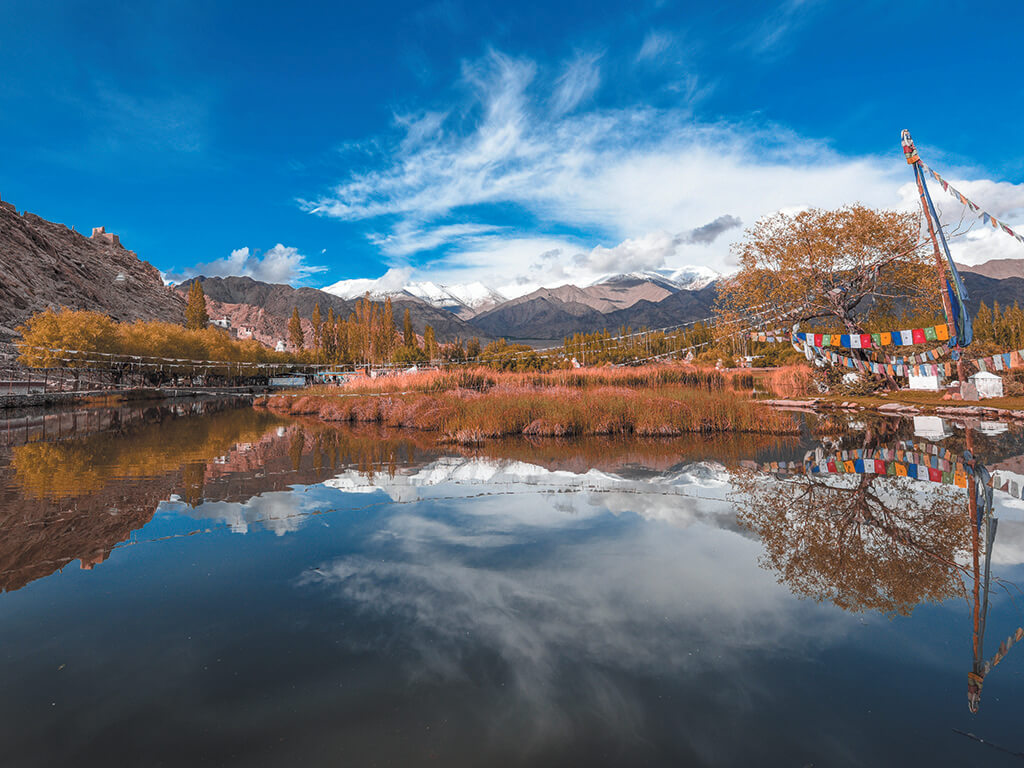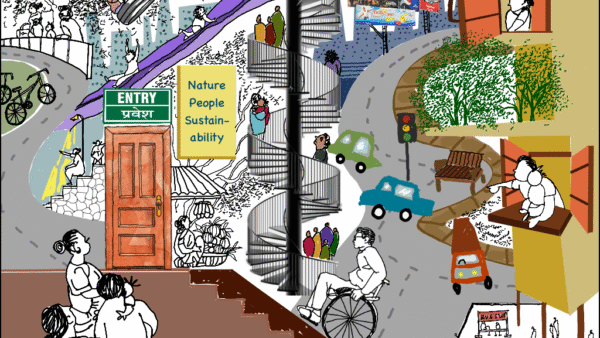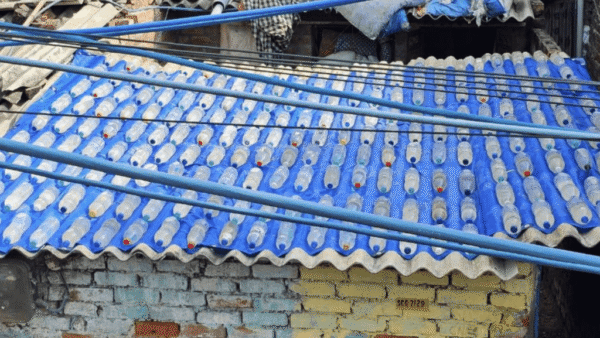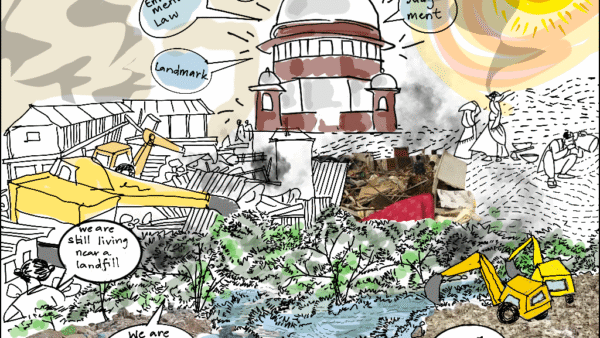The azure blue sky, the brilliant white of floating clouds and rising mountains, the bare brown of shedding trees, and the clean crisp air of Leh-Ladakh that can be breathed in. All this and more were in photographs and videos through March as locals, led by Sonam Wangchuk, went on a climate fast. Their demand was simple but critical: Ladakh’s fragile mountain ecology be preserved and the rights of its indigenous people acknowledged as the union government and corporate India make a beeline here to ‘develop’ the region.
The infrastructural development started by the Centre, when the region became a Union Territory after Article 370 was read down in August 2019, has meant two things. One, the ecologically sensitive Himalayan region of Ladakh and Kashmir, has come under unprecedented stress which holds enormous implications. Two, the people who have lived there for centuries have virtually no say in what kind of ‘development’ projects are undertaken; they demand statehood and the safeguarding of their rights under the Sixth Schedule of the Constitution of India.
Ecological conservation and locals’ rights took on an urgency from late last year as hundreds of people began protests and hunger strikes, but the issues barely caught national attention. When Wangchuk began his 21-day fast on March 6, there was finally some stirring in the rest of India. A prominent Ladakhi voice and a Ramon Magsaysay awardee, Wangchuk kept the photos and videos coming. He began the climate fast, he told Question of Cities, so that the government and policymakers “take note of the pain of the people” of Ladakh and act.
“We are trying to remind and awaken the consciousness of our Prime Minister Narendra Modi and Home Minister Amit Shah to safeguard the fragile ecosystem of the Himalayan mountains in Ladakh and the unique indigenous tribal cultures that thrive here…they will have to show some character and far-sightedness,” Wangchuk stated in a video[1] with his co-fasters milling around.
The climate fast continues; groups of women, followed by the youth, and, later, Buddhist monks will join the fast by turns. Ladakhis want the Modi government to act. The Centre constituted a high-level committee in December 2023[2] to consider their demands and Ladakhi leaders met Home Minister Shah on March 4 but “there was no positive outcome,” they said.[3]
Wangchuk began his fast two days later, surviving on water and salt, and sleeping outdoors at 11,500 feet in sub-freezing temperature while thousands joined him in their own version of the climate fast. Spearheading the action are the Apex Body Leh (ABL) in the Buddhist-dominated areas and the Kargil Democratic Alliance (KDA) in the Muslim-majority areas. The civil society groups, representing the region in the talks with the Centre, emphasise that ‘development’ cannot come at the cost of ecological conservation and rights of locals.
Peaceful climate fasts are the only way forward, they say. The Ladakhis plan a “Pashmina March” from April 7 to focus the attention of the government on the ecologically fragile area of Changthang.

Photo: Faisul Yaseen
Flawed infrastructure development
Changthang is a calling card of the crisis for the past five years. The 20,000-acre plateau lies in the east of Leh along the border with China, its vast swathes of grazing land – portions occupied by the Chinese for the last four years[4] [5] – support a breed of native cashmere goat whose soft fibre is hailed around the world as Pashmina. The goats of the Changthang plateau are reared by the nomadic Changpas.
The shrinking of the grazing land has spelt trouble for thousands of Changpas whose livelihood depends on the Pashmina trade. The union government’s plan to implement a mining policy here could be the deathblow for nature and the people, said Jigmat Paljor, member of the ABL and Wangchuk’s associate. “They want to do this without input from anyone from Ladakh,” he told Question of Cities, “the union government has failed to get back the grazing land occupied by Chinese troops for the last four years”.
The plans for Changthang include wind and solar power plants besides mining and construction projects. “Bureaucrats who have no experience of Ladakh are posted here for two-three years and make decisions; they don’t consult anyone from Ladakh while framing such policies,” Paljor said.[6] Locals understand that Changthang’s grazing lands and mountain slopes are being handed over to corporates in the name of infrastructural development.[7]
Global warming singes
The cold desert, a natural spectacle in itself, has lately been facing climate impact such as depletion of glaciers, flash floods, landslides and droughts.[8] The ‘development’ is likely to worsen this, locals fear. Villagers from Kulul in Leh, battling flash floods every year for the past few years, are on the verge of becoming climate refugees within the region.[9]
“Residents of at least half a dozen mountainous villages including Kulul have shifted to urban centres due to the depletion of glaciers during the past decade,” Paljor said,[10] “The people of Kulul shifted as the village was not getting water when they needed it but there were flash floods.” Sonam Lotus, head of the Meteorological Centre in Leh, explained that the glaciers in Ladakh were receding.[11] “Being a rain shadow zone, the precipitation in Ladakh is just 100 millimetres per year and it is constantly decreasing,” he said.
He calls for regulating tourism – contrary to the government’s push to increase tourist footfalls here – besides adapting infrastructure development to suit the region and shifting to electric vehicles. The government should extend legal protections to Ladakh’s ecosystem and its life-giving glaciers, instead the push has been in the opposite direction, locals say.
The rain-shadow region allowed Ladakhis to not only survive but thrive in the natural environment as melting snow and ice brought them the water they needed. The rapid glacier loss in recent years, beginning before 2019 as global warming spread its tentacles, has increasingly meant erratic snowfall, sudden cloudbursts, and glacial flash floods. Ladakhis were not unaware of solar heating. Wangchuk himself is credited with pioneering the design-and-construction of passive solar-heated buildings and ice stupas[12] in which melted water is re-frozen for later use. However, this was for subsistence; the recent plans are for commercial gain of people with no stake in the region’s sustainability.
Sajad Kargili, social and political activist, said that the Centre has played havoc with Ladakh’s ecology after the reading down of Article 370. There is an absence of regulation on tourist numbers and expeditions like Chadar Trek, which is increasing the carbon footprint.[13]According to him, “the environmental crisis is already out of control” and set to worsen as ‘development’ happens without sustainable environmental policies and without the inputs of locals. “Ladakh is Shimla or Joshimath or Sikkim in the making,” he rues.
Kashmir under siege too
The impact of climate change and the government’s infrastructure push is felt across Kashmir too where the economy is dependent on horticulture, agriculture, and tourism. Climate impact in the Valley was brought home in a powerful way when Omar Abdullah, former chief minister of Jammu & Kashmir and National Conference vice president, posted photos of dry meadows of Gulmarg last winter.
Gulmarg is among the world’s popular destinations for skiing in winter. With a snowless winter for most of the season in 2023, there were many cancellations. Sajad Kralyari, who runs the travel agency Discover Kashmir, said, “Our 60 percent bookings were cancelled in January, there was a drop of 100 percent in foreign tourist arrivals and over 50 percent in domestic tourists.”[14] He added that ski enthusiasts who regularly come from New Zealand, Canada, North America and Europe did not turn up. “They instead went to Kazakhstan as did several Indian tourists.”[15] The horsemen of Gulmarg, sledge-board operators, potters and others were without work.
The absence of snow for a major part of winter also meant that the Khelo India Winter Games had to be postponed.[16] In Srinagar, tourists visiting the famous Tulip Garden were disappointed as the millions of tulips, usually in full bloom by March 19-21, were missing.[17]

Photo: Faisul Yaseen
The ecology of Jammu & Kashmir and Ladakh – separate Union Territories since August 2019 – are inevitably interconnected. The average temperature in Kashmir has risen by 0.5 degrees Celsius in the last four decades, according to Mukhtar Ahmed, director of Kashmir’s meteorological department. A study reveals that between 1980 and 2020, the average annual mean maximum temperature increased by 2 degrees Celsius, marking a substantial increase of 0.5 degree Celsius per decade, far surpassing the global average.[18] There was a deficit in precipitation too.[19] [20]
“This winter was dry for Kashmir and the daytime temperatures in January were unusually high at 15 degrees Celsius,” Ahmad said. The changing weather pattern has led to a shift in agricultural, horticultural and sericulture seasons, affecting both crop quality and crop yield,[21] [22] besides groundwater recharge and glaciers.[23]
“High winter temperature gives the plants a sense of spring and they start blossoming early, which is not healthy for crops,” said Sajad Baba, agricultural economist who teaches at the Sher-e-Kashmir University of Agricultural Sciences and Technology (SKUAST-K). The temperature rise in winter has also impacted the breeding season of fish.
The apathy towards a sustainable environmental policy has also affected hydropower generation; less water discharge in summer has meant less hydropower. Iftikhar Ahmad Drabu, an expert, advises caution before setting up infrastructure projects like power plants. “Though everything is well on paper, there is always something missing,” he said. Hydropower projects in Chenab Valley have meant disposal of construction waste in water bodies and ruthless cutting of trees[24] [25]
Environmental framework for projects needs overhaul
Most of the region falls under Seismic Zone V, a very high damage zone.[26] This makes it crucial for infrastructure development like tunnelling and highway construction to factor in the seismicity but this has hardly been done. If a dam in Chenab Valley breaks, entire villages and cities would be washed out. “We learn to live with this threat,” Drabu said, referring to the forecast of a major earthquake, around 9 on the Richter scale, by the Cooperative Institute of Research in Environmental Sciences (CIRES).
‘On the Brink: A Report on Climate Change and its Impact in Kashmir’ by ActionAid International[27] stated that the environmental and social impact assessment framework for large projects needs a complete overhaul in Kashmir-Ladakh, adding that the government’s assessments did not address all areas of concern. Raja Muzaffar Bhat, environmentalist and RTI activist, remarked that development here could not be done like in Delhi-Gurugram-Noida, Ahmedabad and Nagpur. “But railway and highway projects here are on the same pattern as these places which is detrimental to Kashmir’s ecology.” Besides, the land for these projects is being acquired from small farmers with meagre land holdings.[28]
The disregard for ecology is such that even in Srinagar, governments have failed to find an adequate landfill site or treat even a fraction of the 500 metric tonnes of waste generated every day; this ends up in water bodies and grazing lands nearby. Bhat points out that the Srinagar Smart City projects shrunk roads to make footpaths as in the United States or European cities without inputs from locals.

Photo: Faisul Yaseen
Ecological future in balance
After the devastating 2014 Kashmir floods, Wajahat Iqbal Kashtwari and Tarique Bhat produced the film Kashmir: Into the Murky Waters.[29] Their research showed that a major reason for the massive damage of lives and property was haphazard infrastructural development, the absence of an environmental policy, and a shift from the indigenous practices of environment conservation.
Prominent Kashmiri poet, writer, satirist, and environmentalist, Zareef Ahmad Zareef concurs. “When an autocratic Maharaja Hari Singh handed over Jammu & Kashmir to the Government of India, Kashmir boasted of pristine water bodies and abundance of plants including 42,000 Chinar trees…today, water bodies are in a desolate state, thousands of springs have dried up, and Chinar trees can be counted on fingertips,” he said to Question of Cities. The centralisation of decisions and the marginalisation of local voices draw ire here.
Zareef, who formed the Valley Citizens Council in 1984, took to planting 100 Chinar saplings every year from March 21 to April 15 in mosques, schools, colleges, and police stations – which he stopped in 2019 due to various reasons. However, the saplings he had planted have grown into massive Chinars providing shade to thousands. People like Zareef are not optimistic that the situation will improve. For the young here, like school student Muhammad Ayaan who could not go skiing with his father to Gulmarg, not only their political future but ecological future is at stake too.
To preserve the natural ecology, to ensure that their future is not upended by what passes off for ‘development’ now, and to have the Sixth Schedule applied so that their voice counts, they want the nation’s attention. For Ladakhis and Kashmiris, Sonam Wangchuk is fighting this battle and they are all in it, shoulder to shoulder. Climate fast is their cry.
Faisul Yaseen is a journalist and filmmaker based in Kashmir. His work has featured in Frontline, The Hindu, Arre, and TerraGreen. Previously, Yaseen worked for Hindustan Times and US-based Indiana Daily Student (IDS). He also co-authored a book ‘Environment Chronicles’ published by the Teri Press.
Cover photo: Ladakh; Credit: Wikimedia Commons




